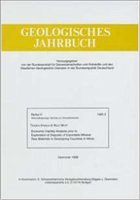Nicht lieferbar

Economic Viability Analysis prior to Exploration of Deposits of Exportable Mineral Raw Materials in Developing Countries in Africa
Versandkostenfrei!
Nicht lieferbar
The study provides a survey of exportable mineral resources in Africa from the point of view of whether exploration is warranted. The study not only provides a detailed documentation of that question, but also divides Africa into regions with potential, marginal potentional, or no potential, in particular with regard to the cost of transportation of mineral commodities from the deposit to the consumer.Mineral deposits and mines often occur at considerable distance from the consumer in the industrial countries. This is why transportation costs often are a large fraction of the total costs and t...
The study provides a survey of exportable mineral resources in Africa from the point of view of whether exploration is warranted. The study not only provides a detailed documentation of that question, but also divides Africa into regions with potential, marginal potentional, or no potential, in particular with regard to the cost of transportation of mineral commodities from the deposit to the consumer.
Mineral deposits and mines often occur at considerable distance from the consumer in the industrial countries. This is why transportation costs often are a large fraction of the total costs and the crude ore value. Transportation costs therefore have considerable impact on the value of the ore concentrate. Since only a few African countries possess smelters, this report primarily focusses on transport to smelters outside Africa.
This study considers the following mineral commodities: antimony, barytes, bauxite, chromium, copper, corundum, fluorspar, gold, graphite, iron, kyanite, lead/zinc, magnesite, manganese, muscovite, nickel, niobium, phosphate, rare earths, tantalum, tin, titanium, tungsten, uranium, vanadium, and vermiculite.
The study demostrates that, on the basis of prices, costs, and grades of the crude ores, exploration for many of the raw materials listed above is considered warranted. For others, this situation will change as conditions become considerably more favourable (higher commodity prices, higher ore grade, improved infrastructures etc).
Die vorliegende Studie vermittelt einen Überblick über die Explorationswürdigkeit ausgewählter exportierbarer mineralischer Rohstoffe. Sie unterteilt Afrika in Regionen mit vorhandenem mineralischen Rohstoffpotential, marginalem Rohstoffpotential, und Regionen ohne Potential an mineralischen Rohstoffe unter Berücksichtigung der Transportkosten von den Lagerstätten zum Verbraucher.
Lagerstätten und Bergwerke sind oft weit entfernt vom Verbrauchermarkt der Industrieländer. Aus diesem Grunde können die Transportkosten einen hohen Anteil an den Gesamtkosten bzw. dem Rohstoffwert ausmachen. Sie beeinflussen den Erz- bzw. Konzentratwert erheblich. Da nur in einigen Ländern Afrikas rohstoffverarbeitende Betriebe bestehen, wurde der Transport zu Hütten außerhalb Afrikas in Betracht gezogen.
In dieser Studie werden die folgenden mineralischen Rohstoffe behandelt: Antimon, Bauxit, Blei/Zink, Chrom, Eisen, Flußspat, Gold, Graphit, Korund, Kupfer, Kyanit, Magnesit, Mangan, Muskovit, Nickel, Niob, Phosphat, Schwerspat, Seltene Erden, Tantal, Titan, Uran, Vanadium, Vermiculit, Wolfram und Zinn.
Die Ergebnisse zeigen, daß viele der o. g. Rohstoffe aufgrund ihrer Preise, Kosten und Erzgehalte Explorationsarbeiten rechtfertigen. Für die übrigen Rohstoffe wird sich die Situation ändern, wenn günstigere Bedingungen (z. B. höhere Rohstoffpreise, höhere Wertstoffgehalte, günstigere Infrastrukturverhältnisse) vorliegen.
Mineral deposits and mines often occur at considerable distance from the consumer in the industrial countries. This is why transportation costs often are a large fraction of the total costs and the crude ore value. Transportation costs therefore have considerable impact on the value of the ore concentrate. Since only a few African countries possess smelters, this report primarily focusses on transport to smelters outside Africa.
This study considers the following mineral commodities: antimony, barytes, bauxite, chromium, copper, corundum, fluorspar, gold, graphite, iron, kyanite, lead/zinc, magnesite, manganese, muscovite, nickel, niobium, phosphate, rare earths, tantalum, tin, titanium, tungsten, uranium, vanadium, and vermiculite.
The study demostrates that, on the basis of prices, costs, and grades of the crude ores, exploration for many of the raw materials listed above is considered warranted. For others, this situation will change as conditions become considerably more favourable (higher commodity prices, higher ore grade, improved infrastructures etc).
Die vorliegende Studie vermittelt einen Überblick über die Explorationswürdigkeit ausgewählter exportierbarer mineralischer Rohstoffe. Sie unterteilt Afrika in Regionen mit vorhandenem mineralischen Rohstoffpotential, marginalem Rohstoffpotential, und Regionen ohne Potential an mineralischen Rohstoffe unter Berücksichtigung der Transportkosten von den Lagerstätten zum Verbraucher.
Lagerstätten und Bergwerke sind oft weit entfernt vom Verbrauchermarkt der Industrieländer. Aus diesem Grunde können die Transportkosten einen hohen Anteil an den Gesamtkosten bzw. dem Rohstoffwert ausmachen. Sie beeinflussen den Erz- bzw. Konzentratwert erheblich. Da nur in einigen Ländern Afrikas rohstoffverarbeitende Betriebe bestehen, wurde der Transport zu Hütten außerhalb Afrikas in Betracht gezogen.
In dieser Studie werden die folgenden mineralischen Rohstoffe behandelt: Antimon, Bauxit, Blei/Zink, Chrom, Eisen, Flußspat, Gold, Graphit, Korund, Kupfer, Kyanit, Magnesit, Mangan, Muskovit, Nickel, Niob, Phosphat, Schwerspat, Seltene Erden, Tantal, Titan, Uran, Vanadium, Vermiculit, Wolfram und Zinn.
Die Ergebnisse zeigen, daß viele der o. g. Rohstoffe aufgrund ihrer Preise, Kosten und Erzgehalte Explorationsarbeiten rechtfertigen. Für die übrigen Rohstoffe wird sich die Situation ändern, wenn günstigere Bedingungen (z. B. höhere Rohstoffpreise, höhere Wertstoffgehalte, günstigere Infrastrukturverhältnisse) vorliegen.



